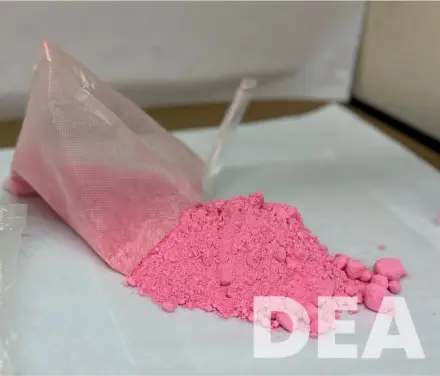A dyed powder called “tusi” or “pink cocaine” is emerging as a dangerous and increasingly popular party drug in major U.S. cities. Despite the name, tusi rarely contains actual cocaine. Instead, it’s often a mix of substances like ketamine, MDMA, or methamphetamine—making it both cheaper to produce and its effects far more unpredictable.
With unknown ingredients and potentially life-threatening side effects, understanding the risks of tusi is essential. In this article, we’ll explain what tusi is, how it affects the brain and body, and what treatment options are available for pink cocaine addiction.
If you or someone you know is at risk, read on to learn how recovery is possible.


Our admissions specialists are available 24/7. Call now to learn more about the admissions process.
People in the club scene in major U.S. cities such as Miami, New York, Los Angeles, and Las Vegas primarily use Tusi. Its popularity stems from its stimulant and hallucinogenic effects, vibrant pink color, and availability in nightlife settings like clubs, raves, and music festivals.
People typically use tusi by insufflation (snorting), often using metal spoons or fingernails, similar to traditional cocaine use. Distributors frequently package pink cocaine in unmarked baggies, with its vivid dyed pink color making it visually distinctive.
Tusi commonly contains MDMA, ketamine, and cocaine. However, its exact composition remains unknown. The ingredients can change from one dealer to another, making it hard to know what users are actually taking.
Users often take the substance to maintain high energy levels and euphoria, especially in environments where they also consume alcohol, ecstasy, or other substances. Users often go back for repeated doses throughout the night, increasing the risk of addiction, dangerous interactions, and overdose.
Because the tusi contains a mixture of unknown substances and is often used with other drugs and alcohol, it produces varying effects from person to person. While some may appear highly energetic or euphoric, others may show signs of confusion, agitation, or even sedation.
Despite cocaine being in the name, pink cocaine rarely contains any. Instead, the drug is a mixture of multiple substances to create a powerful hallucinogenic effect. Tusi rarely comes pure and dealers often mix it with two or more substances, making its effects unpredictable.
Cocaine is a powder simulator that affects the central nervous system to produce a powerful, short-lasting euphoric feeling by increasing the levels of dopamine, norepinephrine, and serotonin in the brain. Unlike pink cocaine, cocaine is more consistent in its composition and effects. However, dealers can cut the drug with other substances like fentanyl.
The main differences between cocaine and pink cocaine are:
The side effects of pink cocaine vary based on the substances in the mixture and the amount a person uses.
Potential side effects can include:
Tusi is dangerous because people do not know what substances they are snorting or ingesting. The unknown combination of drugs can cause side effects that are uncomfortable, harmful, and life-threatening.
Many of the substances commonly found in the drug increase the risk of developing a mental and physical dependence (addiction). A person with tusi addiction may experience a variety of withdrawal symptoms that make it harder to stop using.
Mental health effects: The hallucinogenic effects of the drug can lead to paranoia, severe anxiety, and hallucinations.
Tree House Recovery offers comprehensive treatment programs for drug and alcohol addiction. Our therapies help clients recover from the unique challenges posed by synthetic drugs like tusi.
Our outpatient programs at our California rehab can support long-term recovery after completing detox or inpatient/residential treatment. Some elements of our program that are highly relevant to treating the long-term effects of tusi include:
Every recovery journey is unique. Our admissions team is here to assess your needs and match you with therapies that support lasting change. Call us today to begin your path to healing.
No. Tusi often contains Schedule I drugs, meaning it has no accepted medical use in the United States and has high abuse potential. Federal law prohibits individuals from possessing any Schedule I substance—such as heroin, lysergic acid diethylamide (LSD), marijuana, 3,4-methylenedioxymethamphetamine (MDMA), methaqualone, or peyote.
No. U.S. authorities have classified tusi as having no medical use in treatment.
Pink cocaine can be addictive. The substances often found in the drug carry a high risk of addiction and pose significant health risks.
If you or someone you know is struggling with pink cocaine addiction, you are not alone. Our California rehab center provides personalized tusi addiction treatment, resources, and support from experienced counselors — many with lived experience — to help rebuild your mental, physical, and social health.
Whether you’re seeking outpatient support or continuing care after detox, we’re here to guide you every step of the way. Call (855) 202-2138 today to speak with our admissions team and begin your recovery journey in California.
